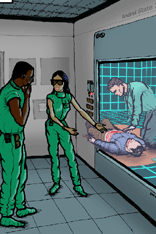The National Library of Medicine has awarded the department of computer science a three-year, $2.6-million contract to develop and test 3-D video technology to enhance medical care at accident scenes and other remote settings.
Researchers will study how 3-D video technology and high-speed mobile networks could improve off-site health-care delivery over the use of existing two-dimensional teleconferencing.
Conventional teleconferencing does not allow full enough immersion into the emergency scenario, said Henry Fuchs, principal investigators and Federico Gil professor of computer science.
Researchers will develop a prototype and test its effectiveness during tracheostomies being performed at UNC Hospitals.
"Tracheostomies do not take long but are critical procedures in many emergencies and have a degree of difficulty," said Fuchs.
"We hope that ultimately this 3-D technology will prove helpful not just in immediate treatment but in the ride in the ambulance to a medical facility, so that an EMT alone with a patient during that ride will not feel so alone."
Airway obstruction is the leading cause of preventable death in situations where patients die en route to the hospital, said Bruce Cairns, co-principal investigator, research director in the N.C. Jaycee Burn Center and assistant professor of surgery in the School of Medicine.
"Testing this technology in an acute situation allows us to assess the hypotheses regarding the capture of these procedures and determine whether we can effectively bring the consultant to the bedside and the bedside to the consultant," Cairns said.
The technical questions involved in extending "telepresence" are substantial, he said, but the need for such advances is intuitively obvious.
Cairns said his experience as a doctor in the U.S. Navy, stationed in Guam, demonstrated the importance of telepresence technology. The closes land mass to Guam was five hours away by air, and his hospital had no neurosurgeon, yet served a civilian and Navy population of about 150,000. He was sometimes called on to operate on patients with life-threatening head injuries, despite having limited training and support in performing neurosurgical procedures.
"If you could use technology to cross geographical barriers, you could extend opportunity to people who live in rural or remote areas," said Cairns. "We believe people should be able to get the very best care they can get and not have their access to specialized acute care limited by where they live."
The other co-principal investigators on the National Library of Medicine project are UNC computer scientists Ketan Mayer-Patel and Greg Welch, and Diane Sonnenwald of Göteborg University and University College of Borås, Sweden. Additional collaborators include Anthony Meyer, professor and chair of UNC's department of surgery; Eugene Freid, associate professor of anesthesiology and pediatrics; and Robert Vissers, assistant professor of emergency medicine.



